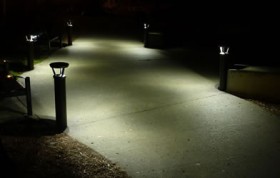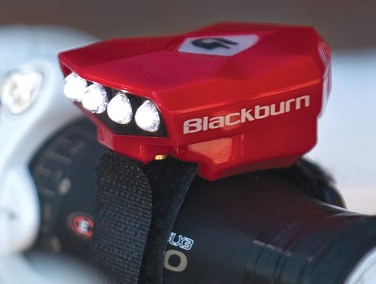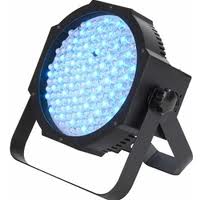
Solar Lights the Way to the Rechargeable Revolution
An entirely new market category of LED products fueled by compact, highly efficient, rechargeable batteries is "paving the way" for new forms of pedestrian-scale lighting – and more. Today's lighting-class LEDs require very little power, and the small size and high lumen packages allow new batteries to fit discreetly within all types of lighting products.
New generations of photovoltaics, LEDs, and batteries are coming onto the market, and this trifecta puts solar solutions in the vanguard of rechargeable illumination. This is an entirely new product category, a standalone alternative to traditional AC lighting fixtures and a class apart from cheap solar garden lights.
Not only does a fully contained lighting unit with battery technology provide a visually clean look, there are significant installation advantages with solar outdoor lighting: wiring, trenching, and environmental site disturbances are largely eliminated. Combine that with zero electrical bills, and the use of solar walkway lighting becomes a no brainer – especially in sensitive or remote areas.
Battle of the batteries
There are two current leaders in battery technology for rechargeable illumination: lead acid, which has the options of absorbed glass mat (AGM), gel and flooded, and the emerging technology, lithium ion, in particular lithium iron phosphate (LiFePO4). Lead acid (think car batteries) is widely available, proven, easily recyclable, and inexpensive. But lithium technologies (think electric cars and power tools) have the advantage of high power density and they can withstand repeated, deep discharges. The lithium batteries are currently more expensive and harder to recycle than lead acid.
Often when describing a battery one would define a cycle life or float life, depending on how the battery is used. A cyclic application, like solar, requires frequent charge and discharge, and for cyclic applications battery life is commonly 3 to 5 years. In float applications, such as emergency lighting, battery life can extend as much as 10 years.
Cyclic life for lead acid batteries is largely dependent upon how much the battery is discharged with each cycle. The greater the daily discharge, the shorter the life. Because lithium-based batteries can withstand frequent deep discharges, their life in a cyclic application is based mostly on temperature, with lifetime decreasing as temperature increases.
In float applications, the battery is fully charged and rarely discharged. For both lead acid and lithium batteries their useful life in float applications will be based on proper charging and ambient temperature, with temperature being the major factor. For example, every 8 degrees above room temperature cuts the float life in half!
One benefit of today's battery technology is the ability to recycle. Some lead acid batteries allow for recovering more than 97% of the lead, and plastic makes them by far the most recyclable. "New" lead acid batteries can contain 60-80% recycled materials. It's a closed-loop life cycle that can continue sustainably.
Rechargeable lighting today and tomorrow
Rechargeable LED light fixtures are commonly used in fixed and portable applications:
PV-powered fixtures for outdoor area lighting (cyclical), including pedestrian and street lighting. Grid-tied emergency lighting (float) is required by the NFPA Life Safety Code for safe egress in rare emergencies. This can be a dedicated emergency lighting fixture or a regularly used luminaire with a battery backup for grid failures. Portable fixtures such as work lights, flashlights, etc. (could be float or cyclical): compact, rechargeable, and reliable.
This third category includes solar-powered products being deployed in rural areas throughout the third world, supported by charities and NGOs. Research reports that these rechargeable lanterns have significant positive impacts on communities, such as the cost savings and improved health and safety realized by eliminating the use of candles and kerosene, and improved performance by students who are able to complete more school homework. On the downside, depleted batteries could become an issue in these regions with few, if any, recycling facilities.



Lithium battery technology is expanding our options even further. From USB-rechargeable LED bike lights by Blackburn to theatrical fixtures to the designer AlessiLux rechargeable line of desk lamps, the category is growing. Battery size is decreasing while battery capacity is increasing; plus, using electronics to regulate the depth of the daily discharge extends battery life.
Improvements in LED efficacy are constantly allowing us to do more with less. At First Light Technologies we have already improved our light output – both hours of illumination and brightness – by simply utilizing the latest generation of low-power-consuming, high-luminous-flux LEDs. This trend will only continue to allow rechargeable products to access new opportunities in mainstream commercial and residential lighting.
This synergy between smaller, longer-lasting batteries and brighter, more-efficient LEDs – and look for continued improvements in the price and power productivity of photovoltaics – is improving the way we light the way.
Written by Evan Quinn, Marketing and Communications Coordinator for First Light Technologies, based in Victoria, BC, Canada. First Light Tehnologies' Solar LED pathway lights, bollards, and custom designs combine robust construction, aesthetic design, and intelligent functionality.





